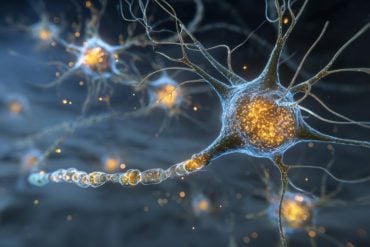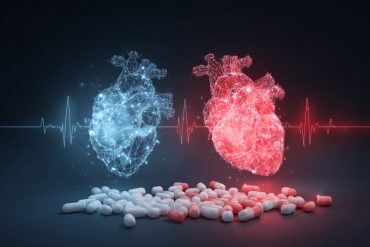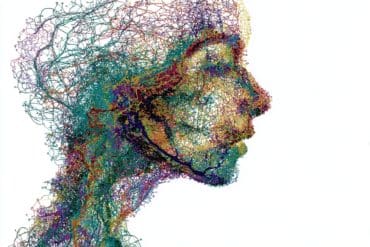Summary: Infection with the SARS-CoV-2 virus causes dials down the action of olfactory receptors, resulting in smell loss associated with COVID-19.
Source: NYU Langone
Researchers have discovered a mechanism that may explain why COVID-19 patients lose their sense of smell.
Published online February 2 in the journal Cell, the new study found that infection with the pandemic virus, SARS-CoV-2, indirectly dials down the action of olfactory receptors (OR), proteins on the surfaces of nerve cells in the nose that detect the molecules associated with odors.
Led by researchers from NYU Grossman School of Medicine and Columbia University, the new study may also shed light on the effects of COVID-19 on other types of brain cells, and on other lingering neurological effects of COVID-19 like “brain fog,” headaches, and depression.
Experiments showed that the presence of the virus near nerve cells (neurons) in olfactory tissue brought an inrushing of immune cells, microglia and T cells, that sense and counter infection. Such cells release proteins called cytokines that changed the genetic activity of olfactory nerve cells, even though the virus cannot infect them, say the study authors.
Where immune cell activity would dissipate quickly in other scenarios, in the brain, according to the team’s theory, immune signaling persists in a way that reduces the activity of genes needed for the building of olfactory receptors.
“Our findings provide the first mechanistic explanation of smell loss in COVID-19 and how this may underlie long COVID-19 biology,” says co-corresponding author Benjamin tenOever, Ph.D., professor in the Department of Microbiology at NYU Langone Health. “The work, in addition to another study from the tenOever group, also suggests how the pandemic virus, which infects less than 1 % of cells in the human body, can cause such severe damage in so many organs.”
Change in Architecture
One unique symptom of COVID-19 infection is loss of smell without the stuffy nose seen with other infections like the common cold, researchers say. In most cases, the smell loss lasts only a few weeks, but for more than 12 percent of COVID-19 patients, olfactory dysfunction persists in the form of ongoing reduction in the ability to smell (hyposmia) or changes in how a person perceives the same smell (parosmia).
To gain insight into COVID-19-induced smell loss, the current authors explored the molecular consequences of SARS-CoV-2 infection in golden hamsters and in olfactory tissue taken from 23 human autopsies. Hamsters represent a good model, being mammals that both depend more on the sense of smell than humans, and that are more susceptible to nasal cavity infection.
The study results build on the discovery over many years that the process which turns genes on involves complex 3-D relationships, where DNA sections become more or less accessible to the cell’s gene-reading machinery based on key signals, and where some DNA chains loop around to form long-range interactions that enable the stable reading of genes. Some genes operate in chromatin “compartments”—protein complexes that house the genes—that are open and active, while others are compacted and closed, as part of the “nuclear architecture.”
In the current study, experiments confirmed that SARS-CoV-2 infection, and the immune reaction to it, decreases the ability of DNA chains in chromosomes that influence the formation of olfactory receptor building to be open and active, and to loop around to activate gene expression. In both hamster and human olfactory neuronal tissue, the research team detected persistent and widespread downregulation of olfactory receptor building.

Other work posted by these authors suggests that olfactory neurons are wired into sensitive brain regions, and that ongoing immune cell reactions in the nasal cavity could influence emotions, and the ability to think clearly (cognition), consistent with long COVID.
Experiments in hamsters recorded over time revealed that downregulation of olfactory neuron receptors persisted after short-term changes that might affect the sense of smell had naturally recovered. The authors say this suggests that COVID-19 causes longer-lasting disruption in chromosomal regulation of gene expression, representing a form of “nuclear memory” that could prevent the restoration of OR transcription even after SARS-CoV-2 is cleared.
“The realization that the sense of smell relies on “fragile” genomic interactions between chromosomes has important implications,” says tenOever.
“If olfactory gene expression ceases every time the immune system responds in certain ways that disrupts inter-chromosomal contacts, then the lost sense of smell may act as the “canary in the coalmine,” providing any early signals that the COVID-19 virus is damaging brain tissue before other symptoms present, and suggesting new ways to treat it.”
In a next step, the team is looking into whether treating hamsters with long COVID with steroids can restrain damaging immune reactions (inflammation) to protect nuclear architecture.
About this COVID-19 and olfaction research news
Author: Press Office
Source: NYU Langone
Contact: Press Office – NYU Langone
Image: The image is in the public domain
Original Research: Open access.
“Non-cell autonomous disruption of nuclear architecture as a potential cause of COVID-19 induced anosmia” by Benjamin tenOever, Marianna Zazhytska et al. Cell
Abstract
Non-cell autonomous disruption of nuclear architecture as a potential cause of COVID-19 induced anosmia
SARS-CoV-2 infects less than 1% of cells in the human body, yet it can cause severe damage in
a variety of organs. Thus, deciphering the non-cell autonomous effects of SARS-CoV-2 infection
is imperative for understanding the cellular and molecular disruption it elicits.
Neurological and cognitive defects are among the least understood symptoms of COVID-19 patients, with olfactory dysfunction being their most common sensory deficit.
Here, we show that both in humans and hamsters SARS-CoV-2 infection causes widespread downregulation of olfactory receptors (OR)and of their signaling components. This non-cell autonomous effect is preceded by a dramatic reorganization of the neuronal nuclear architecture, which results in dissipation of genomic compartments harboring OR genes.
Our data provide a potential mechanism by which SARS-CoV-2 infection alters the cellular morphology and the transcriptome of cells it cannot infect, offering insight to its systemic effects in olfaction and beyond. Journal Pre-pr







